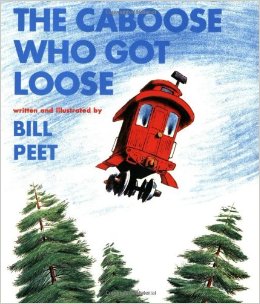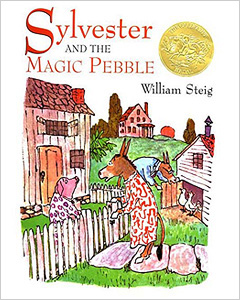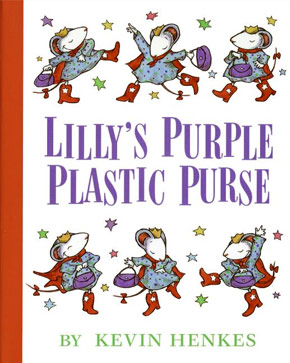
Bill Peet’s books are still huge favorites among children. This one has 1333 words, according to ARBookFind.com.
In the 18-plus years I’ve been a bookseller, the average word count in picture books has dropped, and dropped again, and dropped again. When we opened the bookstore in the mid-1990s, 1,500 words was at the upper limit of what was considered to be an acceptable length. Now that’s a laughable number, and the general rule of thumb is that you’d better watch yourself if you’re over 500.
Why are we so bent on brief? Is it because children have shorter attention spans? (They do. We all do. Or do we?) Is it because parents are working harder than ever and are too tired to face long reading sessions at bedtime with their kids? Possibly. Or is it because we are currently experiencing a trend of short, meta, funny picture books that don’t unfold a story with characters so much as riff on a clever idea? That’s a teeny piece of it, surely.
 If William Steig were to come along now, he likely would be told either to take a strong paring knife to Sylvester and the Magic Pebble (1425 words) or develop it into a chapter book. And Robert McCloskey, with 1,042 words in Blueberries for Sal? Better chop a few kerplinks, buddy. And Bill Peet, bringing Chester the Worldly Pig to a publishing house today? Are you kidding me with those 3,042 words? Get out of my office! And yet, children today still love all of those books with the happy fervor and attention span of children from the eras in which those books were written.
If William Steig were to come along now, he likely would be told either to take a strong paring knife to Sylvester and the Magic Pebble (1425 words) or develop it into a chapter book. And Robert McCloskey, with 1,042 words in Blueberries for Sal? Better chop a few kerplinks, buddy. And Bill Peet, bringing Chester the Worldly Pig to a publishing house today? Are you kidding me with those 3,042 words? Get out of my office! And yet, children today still love all of those books with the happy fervor and attention span of children from the eras in which those books were written.Authors need to earn those word counts, of course. Most manuscripts clocking in with high numbers truly don’t need nearly all of those words to tell their story. But someone like Kate DiCamillo can spin a tale like Louise, the Adventures of a Chicken in 1,419 words and earn all of them.
 I worry that we are underestimating our kids, and in doing so, both pandering to the myths and acceding to the realities of the shorter attention span. Yes, we really do struggle to compete with every other form of entertainment out there. And yes, parents who always read three books at bedtime to their children might dread a really long one. But every single person reading this blog post is someone who understands the magic of a book that connects to your heart and soul, that sweeps your imagination to new places, that tells a worthwhile and memorable story. Those books live in us for a lifetime.
I worry that we are underestimating our kids, and in doing so, both pandering to the myths and acceding to the realities of the shorter attention span. Yes, we really do struggle to compete with every other form of entertainment out there. And yes, parents who always read three books at bedtime to their children might dread a really long one. But every single person reading this blog post is someone who understands the magic of a book that connects to your heart and soul, that sweeps your imagination to new places, that tells a worthwhile and memorable story. Those books live in us for a lifetime.What are some of the long picture books the children you read to love (and sit still for)?

I very much enjoyed your article. I worry the same thing, that we are encouraging the short attention span by proclaiming and pandering to the short attention span. I thought you might enjoy Melanie Heuiser Hill’s essay on this topic, an article we published in Bookology last month:
http://www.bookologymagazine.com/article/how-tom-beat-captain-najork-and-his-hired-sportsmen/
Thank you for being such a strong advocate for kids and reading!
Thanks for this article, Elizabeth. I’m in the process of making a dummy for a picture book manuscript with about 700 words, but I have another one with close to 900. There should be a place for the short-short text and the 1,500 to 3000+ word stories.
Our oldest son would no doubt have been diagnosed as being ADHD if he had been born later. To help calm him down, I read to him. His attention span was unusually long whenever a story was involved. He’s 45 now, and I’ve had the pleasure of reading many of his favorites to our grandchildren. These include: anything by Bill Peet, the LONG Dr. Seuss books such as THE KING’S STILTS and the Horton books, SYLVESTER AND THE MAGIC PEBBLE, all of the Frances books, HARVEY’S HIDEOUT and NOTHING TO DO (two others by Hoban), and by age three, he’d sit still for a whole story from the original Winnie-the -Pooh. We also loved some shorter stories such as Ezra Jack Keat’s Peter tales, all of Leo Lionni’s books, and (his favoirte at age 2) MR GUMPY’S OUTING (by the British author/illustrator John Burningham. I just looked up HARVEY’S HIDEOUT and see that it has over 90% five-star reviews. I think I’ll buy it!
Harvey’s Hideout was one of my sister’s and my FAVORITE books growing up! It was a fantastic story about siblings, and I have always wished someone would bring it back into print. Hint hint, publishers.
Shelly, your son and mine coincide in age, taste in early picture books back when, and ADHD indications. At age three mine was listening with rapt attention to Julie of the Wolves, and the Little House books — as well as enjoying Steig, Hoban, Scarry, Seuss, and all the rest. When it was time to cull the bookshelves around age 10, there were many preschool picture books that were such favorites he begged (successfully) to keep them. The range of taste was enormous.
As a bookseller, I have observed the same in other kids as well: the second grader who was reading Little Women, alternating with Berenstain Bears, for instance.
But there’s another interesting trend that I think bears fostering, namely the illustrated chapter book. For years there seemed to be little middle ground between fully illustrated and strictly text. But over the last 5-10 years, there have been more and more excellent, well-received books whose word count is multiple thousands (e.g. several by DiCamillo), and also a score or more of illustrations. These work as read-alouds for ages 3 and up, or self-reads for the newly literate. Digital reproduction makes it so easy and cheap to integrate text and illustrations. And the appearance of an illustration on the page is a welcome signal to the hesitant emerging reader. Not for nothing has have the Tales of My Father’s Dragon endured for nearly 70 years.
As a teacher who uses pictures books as mentor texts (as well as just reading aloud for pleasure), I have to say I really miss those longer books. My shelves are full of them, but they are older books. Yes, the kids love many of the newer (shorter) books, but they are rarely strong candidates for using as mentor texts as we just can’t get as much out of them as we can with the longer books (generally speaking).
Hi, Elizabeth. I assume the very short length currently being demanded of picture book texts does have, in part, to do with children’s presumed short attention span. But my understanding is that it has even more to do with the assumption that children have matured beyond picture books by the time they enter kindergarten, that they “should” be moving on to longer books in chapters by then. I once had a picture book text purchased by an editor who let it lie on her desk for many years before she moved forward with it. By the time she did, she was wanting lots of adjustments to pull the age down. The text had originally been written for five to eight-year-olds, but she said to me, “Think two.” That our oh-so-sophisticated children have moved beyond picture books at so early an age is a false assumption, of course, but it’s one that seems to have started with parents and the publishers have tumbled after.
Marion, I think you’ve hit on a really important point here — there’s a loop happening between parents wanting to rush their children out of picture books and publishers responding to that ill-advised pressure by going younger and shorter. Teachers still know that picture books are wonderful even for older children, and that picture books themselves represent a huge range of ages and needs. We all need to educate parents about the brilliance of language often found in picture books that isn’t necessarily found in chapter books intended for new readers to tackle on their own. Because picture books are in part meant to be read aloud by fluent readers to young people, they can match and challenge and inspire a child’s wondering mind — which, at those young ages, usually outpaces their solo reading ability.
I’m of a mind that the combination is true, and that we should expand. It IS important to listen to what people want and need. That said, no one excels without those stretches. There’s something about instant gratification, but there’s a great deal to be said about patience, process, relationship. A great story will pull you in and there’s nothing wrong with taking TIME, because ultimately books are about the relationships between the reader and the readee as well as the reader with the written word and story. We dumb it down, I truly believe we risk making not only less imaginative people, but illiterate people. Who benefits from that? Thank you for this article Elizabeth!
and for the record, my stories (two picture books, a baby interactive sound book and in progress midgrade) will be exactly as long as they need to be to tell the story.
Is the word shortening due to publishers wanting to transfer picture books to ebooks and the screens not accommodating text-heavy stories? I’ve tried to shorten some of my stories and have been accused of them now being “too listy.” Bring back the picture-story book with longer text! And tall tales while you’re at it.
I think part of the reason for shorter texts is that illustrations are now working differently. It used to be that they simply illustrated what was in the story. Now a great illustrator brings so much more to a story (and can add almost another story or a subplot!) through their illustrations. As a writer, I’m always thinking what can be left out of the text to allow the illustrator to explore and experiment and create something amazing.
But I do believe there is plenty of room for longer stories – maybe it can be a new trend? Having read of parents pushing their kids into chapter books (and seeing picture books as babyish), I’d love to see a whole new array of long picture books that are not graphic novels (they have their own place).
Great post! My children – and I – enjoy picture books of many lengths. As a writer, I do tend to start writing a PB draft in the 1000-word count area – that’s my sweet spot. But I have learned to prune back to better match market expectations, while not short-changing the reader or my artistic principles. My debut picture book (coming in 2017) will be about 800 words, give or take.
While there are many longer books worth reading and re-reading, my kids adore MIRETTE ON THE HIGH WIRE and all of the BABAR stories. They also enjoy picture-book retellings of legends and folklore, like The Legend of Leelanau from Sleeping Bear Press.
It’s a myth that two year olds don’t have the attention span for longer books. Both of my kids loved Richard Scarry’s Cars and Trucks and Things That Go at that age. It’s 1,917 words long and took 45 minutes to read. It was never a bedtime book, but I sometimes planned for it at nap time. I suppose the interactive nature of finding Goldbug on every page helped keep their attention. But they both knew the story too. I should state for the record that my daughter has ADHD and is turning 14 this year. My son is younger. These are kids brought up in the digital age.
This book is still one of my go to presents for preschoolers. I have never met a toddler who doesn’t love a bananamobile.
It’s not the kids. We are shortchanging them and ourselves. I believe the market has room for both types of picture books: those with shorter texts that promote greater visual literacy and those with longer texts that promote language-based literacy. Both can also support social and emotional development, which is a hallmark of works for children. How they see the world depends on how we present it to them at any age.
I’ve got some affection for longer picture books, seeing as how my debut, The Day-Glo Brothers, was around 2,200 words. (Cut down from the originally submitted 6,200-word version, mind you!) And my firstborn insisted on James Thurber’s not-short-at-all Many Moons.
I have learned to cut, cut, cut, to the point where I tend to write at the shorter length (at least for fiction) from the get-go, but I do wonder what expressiveness might have been lost along the way. If the publishing industry wants to jump on a new trend of longer word counts, I’m there. If Young Adult can give rise to New Adult, then how about Picture Books giving rise to New Picture?
Pingback: Picture book problems - The Horn Book
Great article; important topic. One of my favorites growing up was A BIRTHDAY FOR FRANCES, which weighs in at a cool 1,912 words. Like others, I worry about the effects of ultra-short books on kids’ attention spans–are we accommodating short attention spans or creating them with short books?
I like the phrase “earning the words.” A knee-jerk reaction to cut any words over X isn’t right but every word in a picture book has to earn its way there. If we can write compelling stories with characters and language that engages, the book won’t feel long. The words are earned.
On the other hand, some stories are too long at 500 words.
Hello,
I enjoyed your article but, unfortunately, do not have time to read all the words of all the previous comments. 🙂
I would like to mention a book that my five year old and eight year old are currently asking for every night: Andrew Henry’s Meadow by Doris Burn. It was written in 1965 and, yep, there are times I read a little fast or skip a word or too. I have a feeling she never counted.
It’s absolutely totally worth it, though. It’s a story about independence, community, and for me, listening to children. I’m sure it was very timely in 1965 and it still rings true. Illustrations can’t be beat.
One of my more recent favorites has been Clever Jack Takes the Cake by Candace Fleming. It’s almost 1400 words but I use it as a read aloud for first and second grade students in my library. They love it! I have to admit that when I’m choosing read alouds, I sometimes pass over books with too many words, but if I find a book well written enough, I know it can hold their attention anyway! I think one of the marks of a great book is when the author (and editor) use the exact right amount of words to tell their story, whether it’s a lot or just a few! James Marshall and Mo Willems are fantastic with just a few words, but others like Bill Peet or Roald Dahl spin more complicated tales that require a few more.